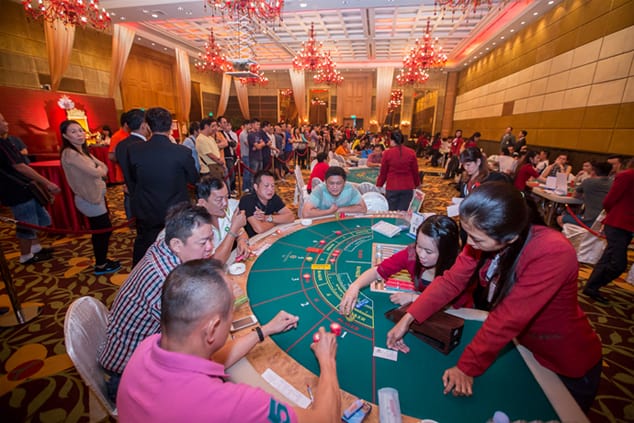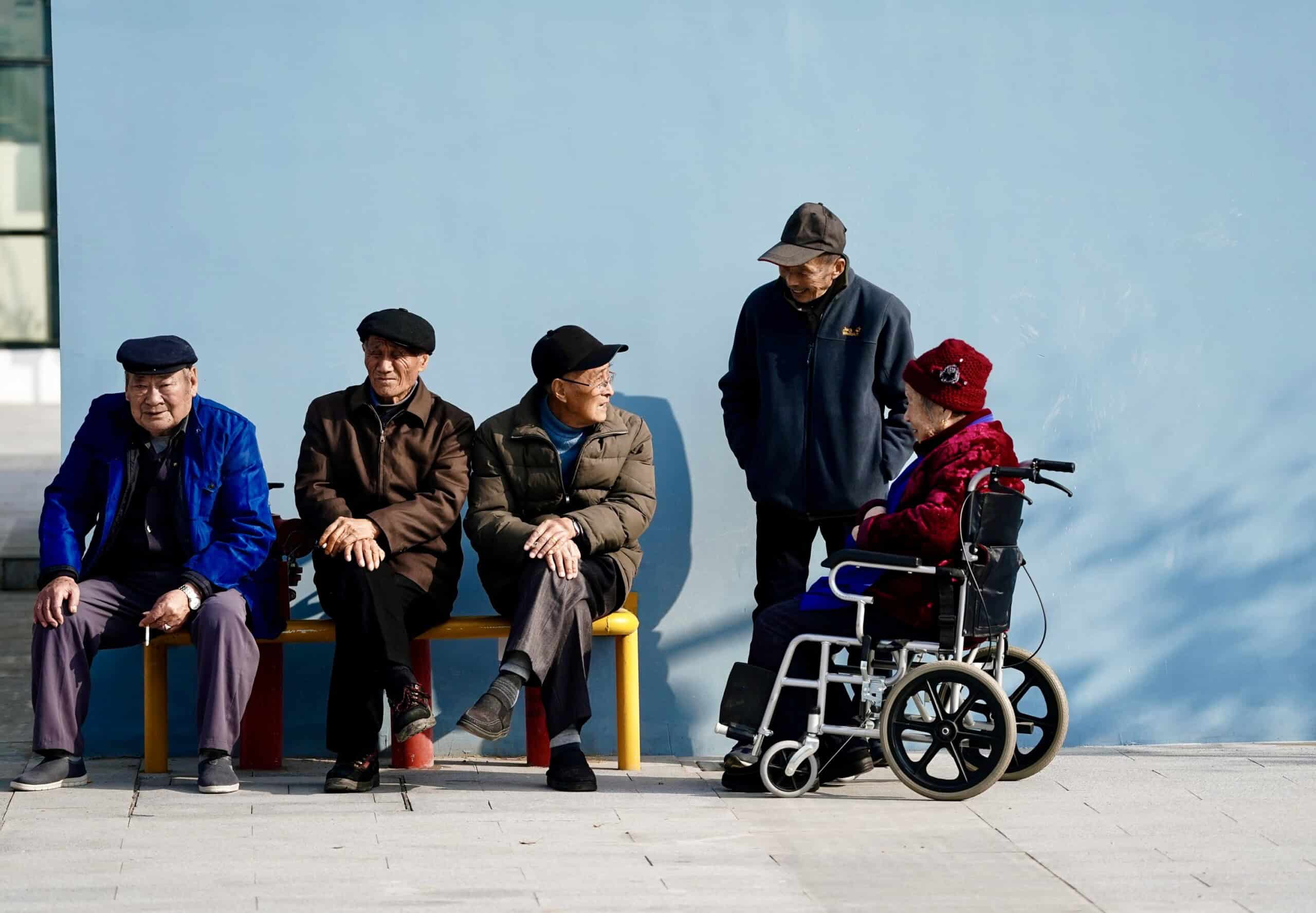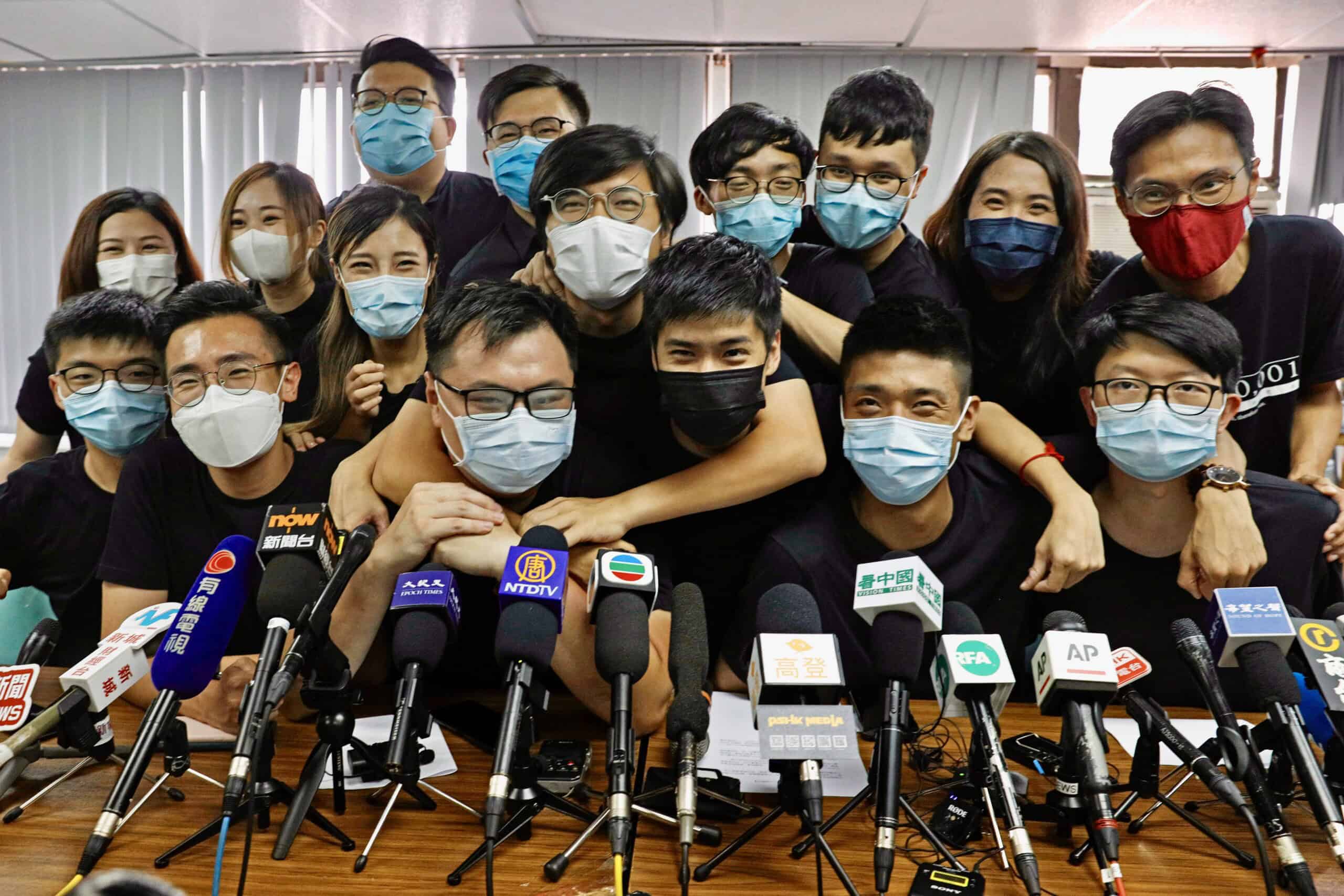
It’s Thursday night at the casino complex NagaWorld, and no one is dancing to the Filipino cover band’s synth-heavy version of Madonna’s “Borderline.” Instead, patrons of the Darlin Darlin Bar, mostly young men, are playing dice games to expedite their imbibing as young waitresses in single-shoulder red gowns shuttle between the bartenders and the tables. At the rear of the bar, a wall of young women in miniskirts chat with each other or look at their phones, waiting for the men to invite them over for a drink.
Finally, the crowd shows some signs of life as the band plays the first few notes of the Teresa Teng tune “Tian Mi Mi,” a Mandarin pop song. At a table near the front, four men, all Chinese, with crew cuts and black t-shirts, raise their glasses of beer and hoot in approval.

Credit: Blemished Paradise, Creative Commons
The Darlin Darlin Bar would not be out of place in any second or third tier Chinese city, but this is Phnom Penh, the capital of Cambodia. And for the patrons here, drinks and music are but a temporary diversion from the night’s main event: baccarat, Texas hold em, roulette and blackjack. When the men finish their beers, they stroll out, looking to claim their treasure from NagaWorld’s tables.
Although little known outside of Phnom Penh, NagaWorld is one of the gambling world’s biggest money-making machines. In 2018, it raked in more than $500 million in profits, propelling a casino in what not long ago was one of the world’s most impoverished countries into the ranks of Asia’s elite gambling emporiums: Singapore’s Marina Bay Sands, Macau’s Wynn Palace and the Resorts World Genting in Malaysia.
“NagaCorp has managed to grab a ride on one of the fastest growing developing economies,” says Ben Lee, an expert in the industry who once worked for NagaCorp and now runs IGamiX, a Macau based gaming industry consultancy.
Las Vegas once ruled the gambling world. But for much of the past two decades, the casino world’s center of gravity has been shifting east, and now coalesces around the borders of the world’s most populous nation, China, where despite a 70-year ban on gambling (or perhaps because of it) there’s an incredible urge among its people to travel overseas and throw the dice.
In fact, the 10 most profitable casino gambling resorts in the world are now all based in Asia, and Macau has far surpassed Las Vegas as the world’s leading gambling destination, largely because it’s a special administrative region and the only territory in China where casinos can legally operate.
But it’s hardly the only place courting China’s increasingly affluent tourists. Singapore and Australia have built glitzy resorts to court Chinese gamblers, as have Vietnam, Laos, Myanmar, Kazakhstan, Russia, South Korea and even the hermit kingdom, North Korea. Virtually every country within 1,000 miles of China’s borders has invested in resorts aimed directly at luring Chinese gamblers.
Here in Phnom Penh, a company called NagaCorp has built a casino complex that is more profitable than even the famed Las Vegas Bellagio — a situation made possible by a steady influx of Chinese tourists who, along with visitors from other parts of Asia, crowd into the city’s increasingly opulent gambling halls and VIP suites. (NagaCorp executives declined to comment for this story.)
Cambodia is also the setting for a peculiar, and even dizzying, scenario that is playing out in other parts of Asia: people leave one country, that forbids them from gambling in casinos at home, to travel to another country that prohibits gambling for its own citizens but welcomes tourists and builds casinos to cater to them. And so while China’s Communist Party leadership forbids gambling in mainland China, its residents are welcome to gamble in casinos set up by its neighbors, sometimes very close to the Chinese border.

Credit: NagaCorp
But in the case of Cambodia, this arrangement is even more striking because the Chinese government seems determined to profit from the traffic it sends to Cambodia and its gambling halls. How? The state-owned China International Travel Service (CITS) leases planes from NagaCorp in order to provide direct charter flights to Phnom Penh from the Chinese cities of Xi’an, Hangzhou, Qingdao and Changsha. A CITS subsidiary, China Duty Free Group, has built an underground duty-free mall connecting the two Naga complexes in Phnom Penh. And China Metallurgical Corporation, a state owned enterprise, has bid to be one of the subcontractors on Naga3, a new $3.5 billion development that is scheduled to open in 2025.
And no one seems to think any of this is particularly strange.
“Even if gambling itself is officially frowned upon within China, tacit or even explicit support for the international gambling industry also helps redirect overcapacity and supply gluts within China’s construction industry, while opening up other avenues for economic expansion,” says Ian Rowen, assistant professor of geography and urban planning at Nanyang Technological University in Singapore.
Business has clearly suffered during the global pandemic, and no one is quite sure how deeply it will affect the company’s bottom line. But there is no indication the company will scale back its ambitions. With its large LED displays lighting up the sky nightly in central Phnom Penh, NagaWorld is the glitziest example of how China is reshaping Cambodia. Prior to the global pandemic, Cambodia had the fastest growing economy in southeast Asia. Analysts say the country is being remade both with China’s help and in China’s image.
ON A HOT STREAK
The story of NagaWorld is the stuff of emerging market legend. In 1993, a new government was formed in Cambodia after the United Nations finished its two-year administration of the country, a move deemed necessary after the horrors of the Chinese-backed Khmer Rouge rule from 1975 to 1979, as well as the Vietnamese invasion and occupation that followed. The new government offered a tender for a casino license that would give its winner a monopoly on casino gaming in the capital city of Phnom Penh, and within a 200 kilometer radius of the city, for 40 years.
Chen Lip Keong, a Malaysian physician of Chinese descent, was the unlikely recipient. Chen had recently arrived in Cambodia in search of economic opportunities, originally seeking to engage in oil exploration in the Gulf of Thailand. He ended up with the rights to the most unexpected gambling empire.

Credit: NagaCorp
“It’s not the business I chose, I planned or I envisioned,” Chen told Forbes in 2018, noting that at the time he had hardly ever stepped into a casino.
But with his license secured, Chen leased a barge, which he converted into a floating casino and moored it in the Bassac River, a muddy channel that splits off of the Mekong near the north side of what is known as Diamond Island. In 1995, the NagaWorld Casino opened for business in a country that at the time had few automobiles or hotels.
Though casino gambling was and is illegal for Cambodian citizens, the barge had a decent stream of business from tourists who arrived in the city from Vietnam, Malaysia and Singapore. Five years later, Chen bought a parcel of land near the city’s political center, not far from Cambodia’s National Assembly, and official residence of the country’s political strongman, Hun Sen. NagaWorld climbed onshore, and opened its first gambling hall in 2003.
That same year, NagaCorp’s application to list on Singapore’s stock exchange was rejected. Cambodia, and Chen’s operation, were seen as too far removed from international norms for security and anti-money laundering efforts, according to analysts. So Chen enlisted an American, Tim McNally, to help bring credibility to NagaWorld.
McNally knew something about gaming. He had been executive director of security and corporate legal services at the Hong Kong Jockey Club, which has a monopoly on betting on horse races, and sports and entertainment in the territory. He had also served, for almost 25 years, as an FBI agent, at one time leading the agency’s Los Angeles office. At NagaCorp, McNally was named chairman in 2005. A year later, in 2006, the company raised $105 million by selling shares to the public with a listing on the Hong Kong Stock Exchange.
The company’s development coincided with China’s decision to relax restrictions it had imposed on the outbound travel of its own citizens. Gradually, more and more Chinese were allowed to apply for passports, and permitted to travel overseas. The numbers are striking. In 1999, about 9 million people left China to travel abroad. By 2010, that figure had jumped to 57 million. Last year, it shot up to 169 million, according to government data.
Some of those tourists arrived in Cambodia to visit the country’s ancient temples, including Angkor Wat, which dates back to the twelfth century. Many also stop in Phnom Penh and, along with a growing number of entrepreneurs who have established garment and other factories in the region, visit the city’s lone casino.
Like what you’re reading? Subscribe today for more in-depth, data-driven storytelling and expert analysis.
Business grew so fast that NagaWorld has been forced to expand its facilities again and again, with each complex designed to be far larger and more extravagant than the one before. When Naga2 opened in late 2017, it featured huge, outdoor LED displays, marble tables, chandeliers and private VIP suites for those who come in on the so-called gambling “junkets” — special trips arranged by brokers to lure big rollers and pamper them with special privileges in exchange for making huge bets that they are likely to lose.
Plans are now underway for an even more audacious Naga3, a complex that NagaCorp says will double NagaWorld’s existing capacity, and include spas, theme parks, two 65-story towers and two additional 45-story towers. U.S. architecture firms Steelman Partners and Skidmore, Owings & Merrill are behind the design, which analysts say is reminiscent of the iconic Marina Bay Sands in Singapore in terms of scope and design. The $3.5 billion resort is scheduled to open in 2025, by which point NagaCorp says it expects tourism to Cambodia will double to 12 million tourists a year, up from about 6 million in 2018.

Credit: Steelman Partners
Shares of the Hong Kong listed company have skyrocketed over the past decade. Much of the company remains in the hands of 72-year-old Chen, who owns 66 percent of NagaCorp’s stock, worth an estimated $3 billion. And perhaps more remarkably, he built the company even though he has spent a good portion of the past 20 years juggling multiple positions. He served as chief executive of a Malaysian government-owned company “responsible for the development of the Malaysian aerospace industry”; helped run a firm that makes steel pipes, and for a while, ran an oil exploration company that carried out projects in Cambodia and Thailand.
His crown jewel, though, is NagaCorp, which churns out huge profits, partly because of special tax breaks and deals awarded by the Cambodian government. Just last year, for instance, the company secured a 10-year extension on its casino monopoly (it is now set to expire in 2045). The company, which is registered in the Cayman Islands, is also exempt from Cambodia’s 20 percent tax on corporate profits. And rather than pay a gaming tax (which in Macau is as high as 35 percent), NagaCorp has arranged to make “obligation payments” that aren’t tied to revenue.
These arrangements, analysts say, have fueled profits of the casino operator, and positioned the company well for a recovery, after the global recession.
“We expect Naga to see a faster recovery relative to regional peers once gaming demand normalises,” Michael Ting, a gaming analyst at CIMB wrote in a recent report.
The company also has few illusions about where its interests lie: in the geopolitical ties between Cambodia, where its gambling resorts are located, and China, which supplies the bulk of its customers.
In a 2018 filing with the Hong Kong Stock Exchange, NagaCorp said the Hun administration’s crackdown on its main opposition party as well as press freedoms had soured relations with the U.S. and Europe, but also helped stabilize the country, making Cambodia “free from heated debates and disruptive demonstrations.”
The filing noted that relations with Beijing had been “strengthened further by these same developments,” noting: “From the perspective of NagaCorp, the improvement in relations with China is more significant than the strain in relations with the US and Europe, since China is a much larger source of tourists to Cambodia than are the US or Europe. Visitors from China are also growing more rapidly than visitors from the US and Europe.”
NagaCorp has made it clear for years that it is aligned with Cambodian leadership. Since 2001, Chen, the founder of NagaCorp, has been an advisor to Hun Sen, one of the world’s longest serving heads of state. In addition to moving Cambodia closer to Beijing, Hun’s increasingly authoritarian actions have alienated the West, which criticized his landslide election victory in 2018.
But analysts say that what the West thinks matters less these days because Cambodia is firmly in China’s orbit. Geographically, an alliance with Phnom Penh allows China to project power into the Gulf of Thailand. Some analysts also say Cambodia serves as a key ally in representing Beijing’s interests in the 10 member Association of Southeast Asian Nations.
Indeed, Hun Sen has made deals with China, embraced its patronage, and abandoned the facade of paying lip service to the democratic freedoms that the U.S. and other democracies had pushed for in exchange for aid.
“The U.S. has, frankly, abdicated its role in Cambodia, focusing on the fool’s errand of trying to force Hun Sen to become more democratic. That is simply not in his DNA,” says Andrew Mertha, director of the China Studies Program at the Johns Hopkins School of Advanced International Studies. “China cannot believe its good luck in finding itself in such a situation.”

Credit: Madoka Ikegami/Pool via Reuters
Now, in exchange for political support and military access, including expansion of the Ream Naval Base in Cambodia, which the Pentagon has said could serve as an unofficial Chinese naval base, China’s big state-owned enterprises have moved into the country. Chinese companies have pledged to invest billions of dollars to help build Cambodia’s infrastructure on a massive scale, including ports, highways, airports, resource extraction plants and hydroelectric dams.
All of which helps NagaWorld.
BETTING THE HOUSE
According to Cambodian legend, the Mekong River is inhabited by multi-headed serpentine beings called Naga. Half creature, half people, the Naga are guardians of a large, underground kingdom full of jewels and palaces, and the Cambodian dynasty itself was first formed when an Indian Brahmin named Preah Thong married the Naga princess, Neang Neak.
Still, to this day, Cambodians say they are “Born from the Naga,” and on a warm evening this past December in Phnom Phen, several people could be found smoking and chatting by the edge of a fountain dedicated to the serpent-beings. The fountain, which sits in the middle of Sihanouk Boulevard, features four brick-red naga scowling menacingly in the four cardinal directions, their tails intertwined and ascending to hold a giant lily pad like a chalice.

Credit: NagaCorp annual report 2017
As traffic bustled around the nearby roundabout, the face of the eastern-gazing naga was lit up by the glow of NagaWorld’s lights. A steady stream of tuk-tuks and Lexus SUVs were delivering Chinese gamblers to the casino that only 16 years ago was itself moored in the Mekong River.
The unlikely NagaWorld juggernaut is the result of a perfect storm of conditions: its monopoly on casino gambling in Phnom Penh, remarkably low tax rates, and Cambodia’s growing alliance with China. Though the global pandemic has slowed tourist arrivals, and analysts have warned of an impact as the company’s stock price slides, Phnom Penh is clearly already being remade by NagaWorld and the arrivals from China.
NagaWorld sits on one side of Hun Sen Park. On the other end, where the Mekong, Tonle Sap and Tonle Bassac Rivers meet, is Diamond Island, a small islet that has morphed into a hub of luxury condominium towers. This area, a ten minute walk from end to end, serves as the epicenter of Chinese spending and investment — a new Chinatown in Phnom Penh.

Credit: Tan Vichet, Creative Commons
Molly Bodurtha, a Fulbright Scholar based in Cambodia and researching China’s push into the region, says while many Chinese state-owned enterprises invest in energy and infrastructure projects, they are also participating in high-end real estate and tourism projects.
“Chinese state-owned firms may not be spearheading projects in Cambodia, but they are certainly participating,” she says.
Wu Juan, a native of China’s Hunan province, has lived on Diamond Island for three years now, selling imported Chinese goods like instant noodles, Tsingtao beer and Zhongnanhai cigarettes to the investors, tourists and businesspeople who occupy the new buildings. She rarely leaves the neighborhood, she says, and estimates that 80 percent of the residents on Diamond Island are Chinese.
“Last year there were more Chinese people here than ever,” she said in early March, noting that business had been good before the coronavirus pandemic halted travel. (In December, though, a visit to the public spaces of the casino indicated that the number of Chinese visitors had dropped dramatically.)
But Eang Vuthy, the executive director of Equitable Cambodia, a nonprofit that serves as a watchdog of foreign investments and developments, says the changes around NagaWorld have happened quickly and can be difficult for the locals to absorb.
“They’re not happy about it,” Vuthy said of the public’s feelings about Chinese investment. “Sometimes [the Chinese investors] hide behind companies, other times they’re in your face.”
The Huangshan International, for example, is one of the many new high-end residential developments currently under construction near NagaWorld. Slated for completion in 2023, the tower will be home to 670 apartments, a tea lounge, Chinese gardens, a fitness club, theater, and a VIP club “that introduces the Chinese antique style of Huizhou architecture.”
But while NagaWorld represents the new Naga kingdom, surrounded by new Chinese development projects, many Cambodians feel they’ve been left behind by the recent economic boom.
Aware of the company’s vast profits, NagaWorld employees went on strike on January 9, demanding a raise of the minimum wage for hotel staff to $300 per month and $500 per month for casino floor staff. Other demands focused on employee well-being, including establishing guidelines regarding physical violence and sexual harassment by guests towards NagaWorld employees.

Credit: Cambodia Center for Human Rights, Creative Commons
“It’s a very serious situation,” said Chhim Sithar, a pit supervisor who has worked at NagaWorld since 2007 and who is president of the NagaWorld union. Gamblers in the VIP rooms, she said, are especially prone to mistreating casino staff, including throwing things at them after losing and groping or sexually propositioning them.
Sithar, 31 years old and a Phnom Penh native, estimated that 65 percent of the incidents involved Chinese, but that others involved wealthy Cambodians gambling there illegally.
Sithar herself was suspended from work last year when she stood up for a colleague who was demanding a higher wage, and one of the striking workers demands was her own reinstatement. The strike was successful, salaries rose and Sitar returned to work. But they are still pressing for better working conditions and waiting for NagaWorld’s casinos to reopen their doors, which were closed because of Covid-19.
NagaWorld’s parent company is now seeking riches beyond Cambodia. The company has broken ground on a new, $300 million casino development in Vladivostok, Russia, a port city in the northeast edge of China, near North Korea.
Russia, as it turns out, has tight restrictions on casino operations, but Vladivostok is preparing to welcome Naga, and there’s no question who the high rollers will be filling its tables and VIP suites.
“The primary source of clients may be from northeast Asia,” according to a report by gaming analysts at China Renaissance, the boutique investment bank, “particularly from China.”

Chris Horton is a Taipei-based journalist whose writing has appeared in The New York Times, The Atlantic, Nikkei Asian Review and elsewhere. Since 2000 he has lived and worked in Shanghai, Kunming, Hong Kong and Taipei. @heguisen



